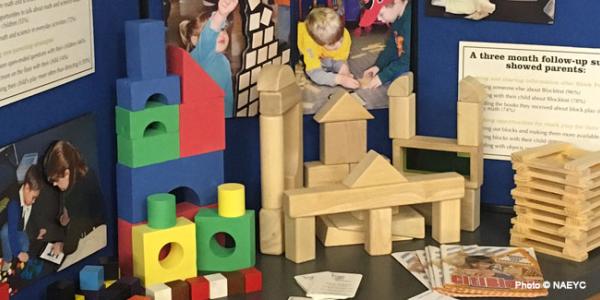“We’re a nation of tinkerers, and dreamers, and believers in a better tomorrow.” - President Obama, White House Science Fair, 2012
Although it might sound small, tinkering couldn’t be more important. It is one of the ways children learn about the world. The STEM subjects (science, technology, engineering, math) offer many opportunities for children to use their minds and hands to play, explore, and learn. Research shows that giving children exposure to quality, hands-on STEM learning opportunities is so important and familiarity with STEM concepts early on is a key predictor of children’s school success.
On April 21, NAEYC, along with many other educational organizations, researchers and thought leaders, helped kick off a White House Early Learning STEM initiative. The initiative seeks to promote the early learning STEM work of local organizations, advocacy groups, associations, philanthropies and businesses. The aim is to increase the research base about young children’s STEM learning, support educators, child care providers, and families in engaging in meaningful STEM learning, promote partnerships with museums and zoos, and increase equitable access and opportunity for all children.
Highlights of Conversations from the STEM Initiative Reception at NAEYC
As a start to the White House STEM Initiative NAEYC hosted a reception where many enthusiastic and dedicated educators shared how they support young children’s STEM learning and tinkering. Among those I spoke with were:
- Patrick Kuhl, of the Institute for Learning & Brain Sciences, University of Washington who described insights into the importance of social interactions to early learning.
- Chip Donahue and Tamar Kaldor from the Erikson institute’s TEC Center who shared thoughts on developmentally appropriate coding for the youngest children (which doesn’t involve coding at all but rather hands-on games where children develop concepts like sequencing and recognizing patterns).
- Denise M. Lewis, the Washington DC Regional Director of FIRST Robotics who demonstrated materials from the Junior First Lego league where children age 6 through 8 design and build a challenge using LEGOS. (Full disclosure: we also talked about the upcoming High School level FIRST Championship 2016 where my son’s team The Body Electric will be competing.)
- And Patricia Kempthorn who shared BLOCKFest, a research-based initiative designed to equip children ages 8 mo.-8 yrs. (and their families) with STEM skills through block play.
NAEYC’s Continuing Commitment to Quality, Accessible STEM Content
NAEYC is dedicated to creating and sharing rich content to support teachers and families who engage children in STEM learning and as part of our involvement in the White House STEM Initiative. We invite STEM educators to submit content to NAEYC’s publishing outlets and we are committed to providing, in the coming year, at least five new pieces of free or low-cost STEM-related content to families and educators in order to foster equitable access to high-quality STEM learning in the homes, centers, schools and communities where young children birth through age 8 spend their time.
This content, which will appear in multiple forms and formats in order to be accessible to a wide and diverse range of families and educators, will be guided by NAEYC’s position statements on Developmentally Appropriate Practice and Technology and Young Children.
From a recent blog entry about a teacher’s science-based inquiry related to “scribbling machines;” to an article in Teaching Young Children that focuses on museum exploration; to resources for families about using “toys as tools” and “bathtime science,” NAEYC is committed to ensuring that resources that support STEM learning are fun, affordable and equitably accessible. We understand that STEM can be a daunting concept for some early childhood education professionals and parents alike, and we aim to ensure that, supported by our content and related professional development opportunities, STEM is elevated and integrated into the daily routines of families and educators – and becomes an integral part of our collective conception of what high-quality early childhood education really means.
For more resources on STEM education, see the new topic page full of resources from NAEYC and other groups.
Look for this and more upcoming STEM content from NAEYC:
- Beyond the Bouncing Ball: Investigating Physics with Toddlers (Young Children, July 2016)
- Setting up a Classroom MakerSpace (Teaching Young Children, August 2016)
- Reflecting on Teaching Length and Measurement to Young Children (Teaching Young Children, August 2016)
Susan Friedman is Senior Director, Publishing and Professional Learning at NAEYC.
